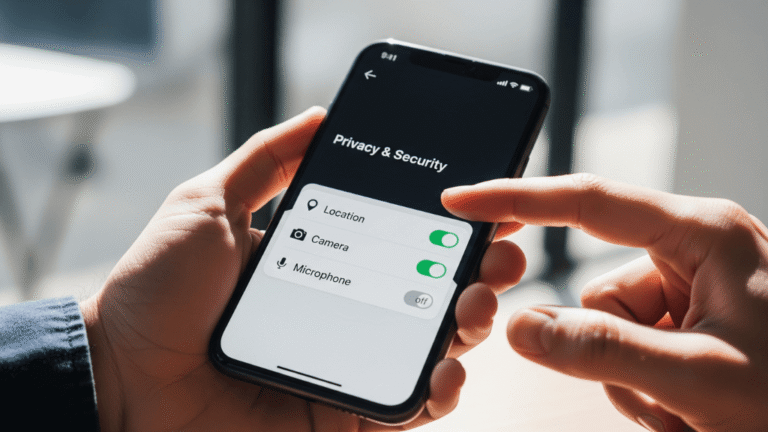AI-generated images have become virtually indistinguishable from real photographs, creating new challenges for media authenticity and personal photo security. With 75% of consumers now aware of AI-generated content and sophisticated tools creating convincing deepfakes daily, knowing how to identify artificial images and protect your own photos has become essential digital literacy. This guide provides practical techniques for detecting AI-generated content and implementing protection strategies for your personal media.
Understanding AI-Generated Images and Current Landscape
AI image generation has evolved dramatically in recent years, with tools like Midjourney, Stable Diffusion, DALL-E, and Adobe Firefly producing increasingly photorealistic results. These platforms use diffusion models and neural networks trained on billions of images to create convincing artificial content that can fool even experienced viewers.
The scale of AI image generation is staggering. Research indicates that 48% of the top 100 websites now offer some form of AI-generated content, more than double the number from 2022. Bitwarden reported a 550% increase in AI-generated content creation in late 2024, with users creating over one million new AI images in just the final quarter.
Detection has become increasingly challenging because modern AI tools can produce images that lack the obvious artifacts present in earlier generations. Professional AI detection services now achieve 95-98% accuracy rates, but human detection remains significantly less reliable. Studies show that untrained humans correctly identify AI-generated images only about 50% of the time—essentially no better than random guessing.
The implications extend far beyond casual photo sharing. AI-generated images are being used for insurance fraud, fake identity documents, misleading advertising, and social media manipulation. Understanding both detection techniques and protection strategies has become crucial for personal and professional security.
Visual Detection Techniques: What to Look For
Despite improvements in AI image generation, certain visual artifacts and inconsistencies remain common giveaways that can help identify artificial content.
Focus on hands and fingers first, as these remain problematic for AI generators. Look for unusual finger positioning, extra or missing digits, unnatural joint angles, or fingers that blend into backgrounds. Even sophisticated AI tools struggle with the complex anatomy and varied positioning of human hands in natural photographs.
Examine text and writing carefully, as AI often produces gibberish or distorted lettering. Signs, logos, license plates, and written text in AI images frequently contain nonsensical characters or malformed letters. This occurs because AI training focuses on visual patterns rather than linguistic accuracy.
Check facial features and skin texture for unnatural smoothness or artificial perfection. AI-generated faces often lack the subtle imperfections, pores, wrinkles, and texture variations present in real photographs. Look for overly airbrushed appearances or skin that appears too flawless to be natural.
Analyze lighting and shadow consistency throughout the image. AI generators sometimes struggle with complex lighting scenarios, creating shadows that don’t match light sources or illumination that seems to come from multiple conflicting directions. Pay attention to how light falls on different objects within the same scene.
Look for background anomalies and impossible architectural elements. AI-generated environments may contain buildings with impossible geometry, trees that grow in unnatural patterns, or objects that blend illogically into backgrounds. These inconsistencies often appear in areas that seem secondary to the main subject.
Advanced Analysis Methods and Tools
Beyond visual inspection, several technical approaches can help identify AI-generated content with greater accuracy.[39][36][33]
Reverse image searching provides valuable context about image origins. Use Google Images, TinEye, or other reverse search tools to find where images appear online. AI-generated images typically have limited search results and may not appear in multiple legitimate contexts like authentic photographs.
Metadata analysis can reveal creation information, though this method has limitations. Examine EXIF data for camera information, GPS coordinates, and creation timestamps. AI-generated images often lack typical camera metadata or contain artificial creation data, though this information can be easily manipulated.
AI detection tools offer automated analysis, though results vary significantly in reliability. Services like Hive AI, Reality Defender, and Sightengine use machine learning algorithms to identify AI-generated content. However, these tools can produce false positives and may struggle with the latest generation of AI images.
Content Credentials technology represents the most promising long-term solution for image authenticity. Developed by Adobe and the Content Authenticity Initiative, Content Credentials embed cryptographically signed metadata that tracks image creation and editing history. Look for the “CR” icon on supported platforms, indicating Content Credentials are present.
Professional detection services provide higher accuracy for critical applications. Companies like Sensity AI and Attestiv offer enterprise-grade detection services with accuracy rates above 95%, though these services typically require specialized access and may not be suitable for casual use.
Content Credentials and Authentication Technology
Content Credentials represent the most significant advancement in digital media authenticity, providing a “digital nutrition label” for images and other content.
The technology works by embedding tamper-evident metadata directly into image files. This metadata includes information about who created the content, what tools were used, and any modifications made during the editing process. Unlike traditional metadata, Content Credentials use cryptographic signatures that make tampering immediately detectable.
Major platforms are implementing Content Credentials support, including LinkedIn, Behance, and YouTube. Adobe automatically applies Content Credentials to images generated with Firefly, providing clear identification of AI-generated content. The metadata persists even when images are shared across different platforms and services.
Viewing Content Credentials requires supported platforms or tools like Adobe’s Inspect service. The free Inspect tool allows anyone to upload images and view associated Content Credentials, providing detailed creation history and authenticity information. Browser extensions are also available for checking credentials on any website.
The Content Authenticity Initiative (CAI) and Coalition for Content Provenance and Authenticity (C2PA) have developed open standards that ensure interoperability between different platforms and tools. This standardization means Content Credentials will work consistently across various services and applications.
Implementation continues expanding, with camera manufacturers, social media platforms, and content creation tools adding support. Future developments may include automatic Content Credential generation for smartphone cameras and mandatory authenticity labeling for online content.
Protecting Your Own Photos from Misuse
Personal photo protection has become increasingly important as AI tools make it easier to manipulate and misuse images without permission.
Limit sharing of high-resolution images containing clear facial features or identifying information. Social media platforms often reduce image quality, but original high-resolution photos provide more data for potential AI manipulation. Consider the long-term implications before sharing detailed personal images publicly.
Apply Content Credentials to your own images when possible using supported Adobe applications. This creates a verifiable record of your ownership and the image’s authentic origin, making it more difficult for others to claim ownership or credibly manipulate your photos.
Use watermarking for important images, though understand that sophisticated AI tools can often remove watermarks. Visible watermarks deter casual misuse but may not stop determined bad actors. Consider embedding watermarks in less obvious locations or using multiple watermarking techniques.
Monitor your image usage online through reverse image searching and specialized services. Regularly search for your photos using Google Images or services like TinEye to identify unauthorized usage. Some services can alert you when your images appear in new online locations.
Adjust privacy settings on social media platforms to limit who can download or share your images. Most platforms offer settings that restrict image saving or sharing, though these protections can often be circumvented by determined users.
Consider the legal implications of photo misuse and understand your rights regarding image manipulation. Some jurisdictions have specific laws protecting against deepfakes and unauthorized image manipulation, particularly for non-consensual intimate images or identity fraud.
Platform-Specific Detection and Safety Features
Different platforms have implemented varying approaches to AI-generated content detection and user protection.
Social media platforms like Facebook, Instagram, and Twitter are implementing AI detection systems, though effectiveness varies. These platforms face the challenge of processing billions of images daily while maintaining user experience. Detection systems may flag obvious AI content but struggle with sophisticated generations.
Professional networks like LinkedIn have begun displaying Content Credentials where available, providing transparency about image authenticity. Business users should pay particular attention to profile photos and professional imagery that may be artificially generated for fraudulent purposes.
Dating platforms face particular challenges with AI-generated profile photos and deepfakes. Be especially vigilant about photos that seem too perfect or professional, particularly if other profile elements seem inconsistent or limited.
News and media websites are implementing various authenticity measures, from Content Credentials to editorial policies about AI-generated imagery. Reputable news sources typically label AI-generated content clearly, while less reliable sources may use artificial images without disclosure.
E-commerce platforms deal with AI-generated product images and fake reviews accompanied by artificial photos. Be suspicious of product photos that seem unusually perfect or professional compared to user-generated content, particularly for lower-priced items.
Staying Current with Evolving Technology
AI image generation technology evolves rapidly, requiring ongoing attention to new detection challenges and protection strategies.
Follow trusted sources for updates on AI detection techniques and new threats. Academic research, security companies, and technology journalism provide valuable insights into emerging trends and detection methods. Subscribe to alerts from organizations like the Content Authenticity Initiative for industry updates.
Update your detection tools and browser extensions regularly to maintain effectiveness against new AI generation techniques. AI detection services continuously improve their algorithms to handle new generation methods, but older versions may miss the latest AI-generated content.
Participate in digital literacy education to improve your personal detection skills. Many organizations offer training on identifying AI-generated content and understanding digital media manipulation. These skills become more valuable as AI technology continues advancing.
Understand the limitations of current detection methods and avoid overconfidence in any single approach. No detection method is foolproof, and the most reliable approach combines multiple techniques including visual inspection, technical analysis, and contextual evaluation.
Stay informed about legal and regulatory developments regarding AI-generated content. Governments worldwide are developing legislation about deepfakes, AI disclosure requirements, and image manipulation, which may affect how platforms handle synthetic content.
Building Comprehensive Media Literacy
Effective protection against AI-generated content requires broader media literacy skills beyond simple detection techniques.
Develop healthy skepticism about online content without becoming paranoid. Question images that seem too perfect, too convenient, or too aligned with specific narratives. This applies particularly to politically charged content, viral social media posts, and news stories that seem designed to provoke strong emotional reactions.
Verify information through multiple independent sources before sharing or acting on content. Cross-reference images and stories across different platforms and news sources. Be particularly cautious about content that appears on only one platform or source.
Understand the motivations behind AI-generated content creation. Some artificial content is created for entertainment or artistic purposes, while other content aims to deceive, manipulate, or defraud. Context and source credibility provide important clues about intent.
Recognize the role of confirmation bias in AI content acceptance. People are more likely to believe artificial content that confirms their existing beliefs or opinions. Be especially skeptical of content that perfectly aligns with your worldview or triggers strong emotional responses.
Develop source evaluation skills that go beyond individual image analysis. Consider the credibility of websites, social media accounts, and news sources sharing content. Established organizations with editorial standards are less likely to share unverified AI-generated content.
Frequently Asked Questions
How accurate are AI detection tools?
Professional AI detection services achieve 95-98% accuracy rates, but free consumer tools vary significantly in reliability. No tool is perfect, and accuracy decreases with newer AI generation techniques. Combine multiple detection methods for best results.
Can AI-generated images be completely undetectable?
Current AI generation still produces detectable artifacts for trained observers, but the gap is narrowing rapidly. Future AI tools may produce truly undetectable images, making authentication technologies like Content Credentials increasingly important.
What should I do if someone creates fake images of me?
Document the fake images with screenshots, report them to platform administrators, and consider legal action if the misuse causes harm. Some jurisdictions have specific laws against non-consensual deepfakes and image manipulation.
Are Content Credentials foolproof?
Content Credentials provide strong authenticity verification but require widespread adoption to be fully effective. They can be stripped from images or may not be present on all platforms. They represent the best current solution but aren’t universally implemented.
How can I tell if a news photo is AI-generated?
Check for Content Credentials, verify the image through reverse searching, look for visual artifacts, and cross-reference with multiple news sources. Reputable news organizations typically label AI-generated content clearly.
Should I be worried about AI-generated content in general?
AI-generated content has legitimate uses in art, design, and entertainment. The concern lies in undisclosed artificial content used for deception, fraud, or manipulation. Focus on developing detection skills and supporting transparency initiatives.
What’s the future of image authenticity verification?
Content Credentials and similar authentication technologies will likely become standard across platforms and devices. Camera manufacturers may begin embedding authentication metadata automatically, making image provenance more transparent and verifiable.
Navigating the complex landscape of AI-generated content requires both technical knowledge and strategic implementation. BMPROW specializes in digital authenticity solutions and can help businesses implement content verification systems, staff training programs, and security policies that address AI-generated content risks. Our team understands the evolving challenges of digital media authenticity and can develop comprehensive strategies for protecting your organization against synthetic content threats. Contact us to discuss how we can help you maintain trust and security in an age of increasingly sophisticated AI-generated content.




